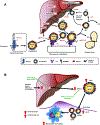Emerging Targets for Cardiovascular Disease Prevention in Diabetes
- PMID: 32423639
- PMCID: PMC7395866
- DOI: 10.1016/j.molmed.2020.03.011
Emerging Targets for Cardiovascular Disease Prevention in Diabetes
Abstract
Type 1 and type 2 diabetes mellitus (T1DM and T2DM) increase the risk of atherosclerotic cardiovascular disease (CVD), resulting in acute cardiovascular events, such as heart attack and stroke. Recent clinical trials point toward new treatment and prevention strategies for cardiovascular complications of T2DM. New antidiabetic agents show unexpected cardioprotective benefits. Moreover, genetic and reverse translational strategies have revealed potential novel targets for CVD prevention in diabetes, including inhibition of apolipoprotein C3 (APOC3). Modeling and pharmacology-based approaches to improve insulin action provide additional potential strategies to combat CVD. The development of new strategies for improved diabetes and lipid control fuels hope for future prevention of CVD associated with diabetes.
Keywords: angiopoietin-like; apolipoprotein C3; atherosclerosis; diabetes; genetics; insulin.
Copyright © 2020 Elsevier Ltd. All rights reserved.
Conflict of interest statement
Disclaimer Statement N.O.S. has received an investigator-initiated grant from Regeneron. K.E.B. and J.E.K. have received research support from Novo Nordisk A/S.
Figures



References
-
- Benjamin EJ et al. (2019) Heart Disease and Stroke Statistics-2019 Update: A Report From the American Heart Association. Circulation 139 (10), e56–e528. - PubMed
-
- Beckman JA et al. (2013) Diabetes and vascular disease: pathophysiology, clinical consequences, and medical therapy: part II. Eur Heart J 34 (31), 2444–52. - PubMed
-
- de Ferranti SD et al. (2014) Type 1 diabetes mellitus and cardiovascular disease: a scientific statement from the American Heart Association and American Diabetes Association. Circulation 130 (13), 1110–30. - PubMed
Publication types
MeSH terms
Substances
Grants and funding
- R35 HL150754/HL/NHLBI NIH HHS/United States
- U24 DK076169/DK/NIDDK NIH HHS/United States
- U24 DK115255/DK/NIDDK NIH HHS/United States
- R01 HL126028/HL/NHLBI NIH HHS/United States
- DP3 DK108209/DK/NIDDK NIH HHS/United States
- R01 HL131961/HL/NHLBI NIH HHS/United States
- R21 AI135447/AI/NIAID NIH HHS/United States
- P30 DK017047/DK/NIDDK NIH HHS/United States
- R01 HL127694/HL/NHLBI NIH HHS/United States
- UM1 HG008853/HG/NHGRI NIH HHS/United States
- R01 DK121756/DK/NIDDK NIH HHS/United States
- P01 HL092969/HL/NHLBI NIH HHS/United States
LinkOut - more resources
Full Text Sources
Medical
Miscellaneous

